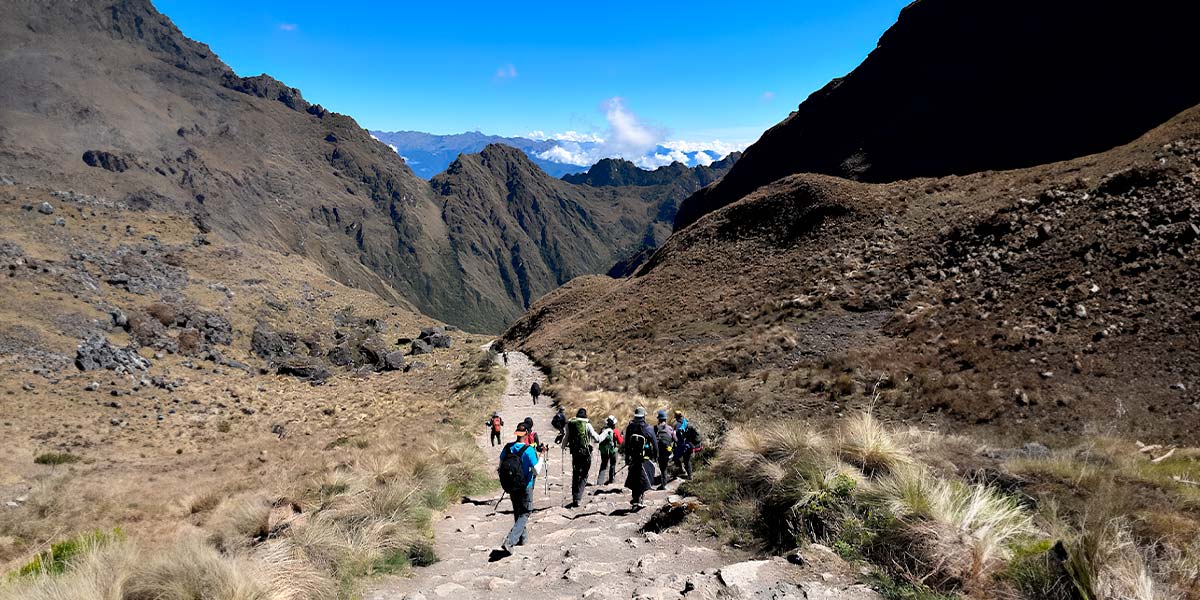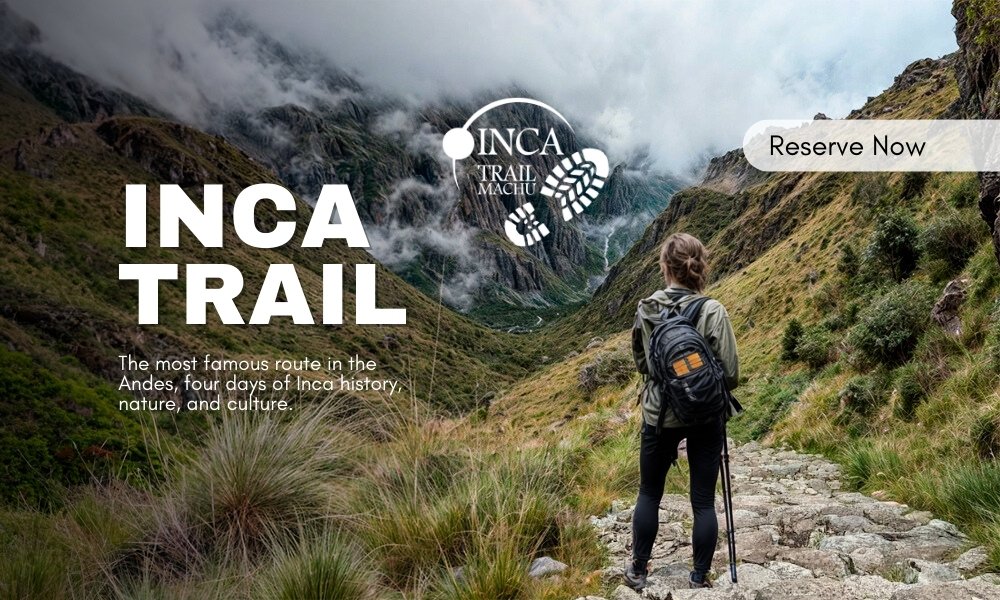
To connect their vast territory, which extended over much of South America, the Incas built a monumental network of roads called Qhapaq Ñan, which came to cover more than 30,000 kilometers. Today, when people ask Where is the Inca Trail?, they usually refer to the most famous section of this ancestral network, a route that is found in Peru. This legendary trek is only a small, but spectacular, portion of that ancient road system that connected the empire.
The specific route of the Inca Trail to Machu Picchu was mapped out for the modern world thanks to an expedition in 1942, decades after the Inca citadel was revealed to the world. Since then, thousands of adventurers each year seek the answer to Where is the Inca Trail to Machu Picchu? to travel its 43 kilometers of history and amazing landscapes.
The journey does not just lead to Machu Picchu Peru; it is a historical trek that passes through impressive archaeological centers like Llactapata, Runkurakay, Sayacmarca, and the magical Wiñaywayna before arriving at the archaeological complex.
So, where does the Inca Trail start exactly? The starting point of the classic Inca Trail, known as the beginning of the Inca Trail, is at Piscacucho, better known as Kilometer 82 of the railway that goes from Cusco to Aguas Calientes. This is the precise answer to every hiker's fundamental question: where does the Inca Trail start and end? It starts at this point in the Sacred Valley and ends four days later at the Inti Punku or Sun Gate, the ancient entrance to the wonder of the world.
This entire 4 day Inca Trail adventure is organized and departs logistically from the city of Cusco Peru. If you plan to travel this trail to the Inca citadel of Machu Picchu, you must know that it is mandatory to hire an authorized tour. Securing your spot is the first step to walking on stone stairs that seem to climb to the sky and having an unforgettable experience.
The Inca trail permits can only be obtained by a tour operator. There are 255 tour operator autorizat in Peru.
Between April and October is when more tourists travel to Cusco Machu Picchu. Keep this in mind when planning your trip and excursion to the Inca Trail.

Versions of the Inca Trail to Machu Picchu
Not all people have the necessary days to travel the Inca Trail (4 days and 3 nights). That is why there are 2 versions depending on the time that is counted:
Classic Inca Trail
Duration: 4 days and 3 nights
Distance: (43 kilometers of hiking).
Short Inca Trail
Duration: 2 days and 1 night
Distance: 16 kilometers of walk.
In the Classic Inca Trail it is possible to hike in less time or add an extra day. It is also possible to add the sacred mountain of Salkantay, 3 day more. For example:
Where the Inca Trail begins?
The answer to where does the Inca Trail begin? depends on the route you choose. There are two official versions of the tour, each with a different starting point, designed for different types of travelers and time availability. Below, we detail each one.
Classic Route - Inca Trail 4 Days
The start of the Inca Trail in its most famous and complete version is at Kilometer 82 of the railway, in an area known as Piscacucho. From this checkpoint, hikers cross the Urubamba River to officially begin the adventure of the Inca Trail Peru. The first day is excellent acclimatization, a walk through a relatively dry valley with views of local communities and the impressive archaeological site of Llactapata. The day ends at the first camp in Huayllabamba, at about 3,000 meters of altitude, where the night in the Andes prepares you for the challenges to come.
The real challenge of this route defines its epic character. The second day is the most demanding, with the ascent to the Warmiwañusca pass or "Dead Woman's Pass", the highest point of the trek at 4,215 meters. After conquering this summit, the third day offers an incredible visual reward, as the landscape transforms drastically upon descending into the humid and lush cloud forest. In this section, spectacular ruins like Runkuracay and the magical Wiñaywayna are explored. The journey concludes at dawn on the fourth day with a final walk towards the Inti Punku (the Sun Gate), arriving just in time to see the sunrise over the sacred city of Machu Picchu, thus answering the question of where does the Inca Trail begin and end?.
Short Inca Trail - Inca Trail 2 Days
For those travelers with less time or who are looking for a less physically demanding experience, there is the Short Inca Trail. The starting point for this version is much further ahead, at Kilometer 104 of the same railway. This route, although shorter, does not skimp on beauty. It allows hikers to experience the final and most spectacular section of the original trail, including a visit to the impressive archaeological site of Wiñaywayna, which many consider as beautiful as Machu Picchu itself, before ascending towards the famous Sun Gate.
The great difference of this route lies in the time and way the citadel is experienced. After arriving at the Inti Punku in the afternoon and getting a first panoramic view of Machu Picchu at sunset, hikers descend to the town of Aguas Calientes to spend the night comfortably in a hotel. The next day, with renewed energy, the full guided tour of "The Lost City of the Incas" is done from early in the morning. This option also offers the flexibility of adding the Huayna Picchu Hike (reserving with due advance), a possibility that is not viable on the classic 4 day route.
About tickets to enter the Inca Trail
Due to the high demand for tickets, you must get entry tickets to the Inca Trail a long time in advance (6 months). The purchase is made only through the Internet through the website of an authorized tourism agency. In total 500 people enter the trails of the Inca Trail every day. Of them, only 200 are tourists. The rest is support personnel such as cooks, porters, guides. The ticket to enter the Inca Trail includes the support staff.
Did not find availability to do the Inca Trail?
The only way to enter the Wonder of the World is by train through the Sacred Valley of the Incas or through the alternative route from Santa María to Machu Picchu. Booking Machu Picchu 2025 &2026 in advance.

What Others Don't Tell You
- How much weight do the porters really carry?
Many people wonder about the human logistics behind this great adventure, especially about the incredible work of the porters. It is important to know that their well-being is protected by the "Porter Law" a Peruvian regulation that establishes that the maximum weight a porter can carry is 20 kilograms. This weight includes their 5 kilograms of personal belongings, so they carry a maximum of 15 kilograms of the group's equipment. This is the reason why agencies limit the weight of the duffel bag that hikers hand in, thus ensuring fair treatment and compliance with the law for these true heroes of the mountain.
- What happens if I can't continue halfway through?
A valid concern is what happens if, due to altitude sickness or exhaustion, you feel you cannot continue. While this is a situation that is best avoided with good acclimatization, the teams are prepared for it. If a hiker cannot go on, the main guide will evaluate the situation and, if necessary, coordinate the evacuation. Normally, a porter or assistant guide will accompany the person back to the nearest starting point, from where their transport back to Cusco will be organized. It is crucial to understand that the costs associated with this return (transportation, lodging, etc.) are not included in the tour price and must be covered by the traveler.
- What are the bathrooms on the route really like?
The reality of the sanitary facilities is a very frequent but little-discussed question. The bathrooms along the Inca Trail are very basic. In most of the government campsites, you will find latrines or "hole in the ground" type toilets, whose cleanliness can be variable. For this reason, it is essential that you bring your own toilet paper, wet wipes, and hand sanitizer. However, to improve the experience, most high-quality agencies, like ours, include in their service a portable and private chemical toilet that is set up in a tent for the exclusive use of the group, ensuring greater hygiene and comfort throughout the entire journey.
- And what about specific equipment like walking sticks or drones?
Many wonder about specific equipment like trekking poles and drones. Trekking poles are highly recommended, as they significantly reduce the impact on the knees, especially on the descents. However, it is a strict rule that these poles must have rubber tip protectors so as not to damage the original Inca stone pavement. As for drones, the answer is a resounding no. Their use is strictly forbidden along the entire Inca Trail and within the Sanctuary of Machu Picchu. The park rangers are very strict with this rule and any drone will be confiscated immediately.
Best Tours in Peru
Peru offers fascinating experiences that reveal natural landscapes, historical monuments, and living cultures, captivating those who seek adventure and discovery in every corner of its territory. Get to know the most outstanding tours:
Other trips in Peru
If you want to visit Machu Picchu, we recommend you to book your Machu Picchu Entrance Tickets in advance, so you will enjoy your Vacation in Machu Picchu without any problem.
